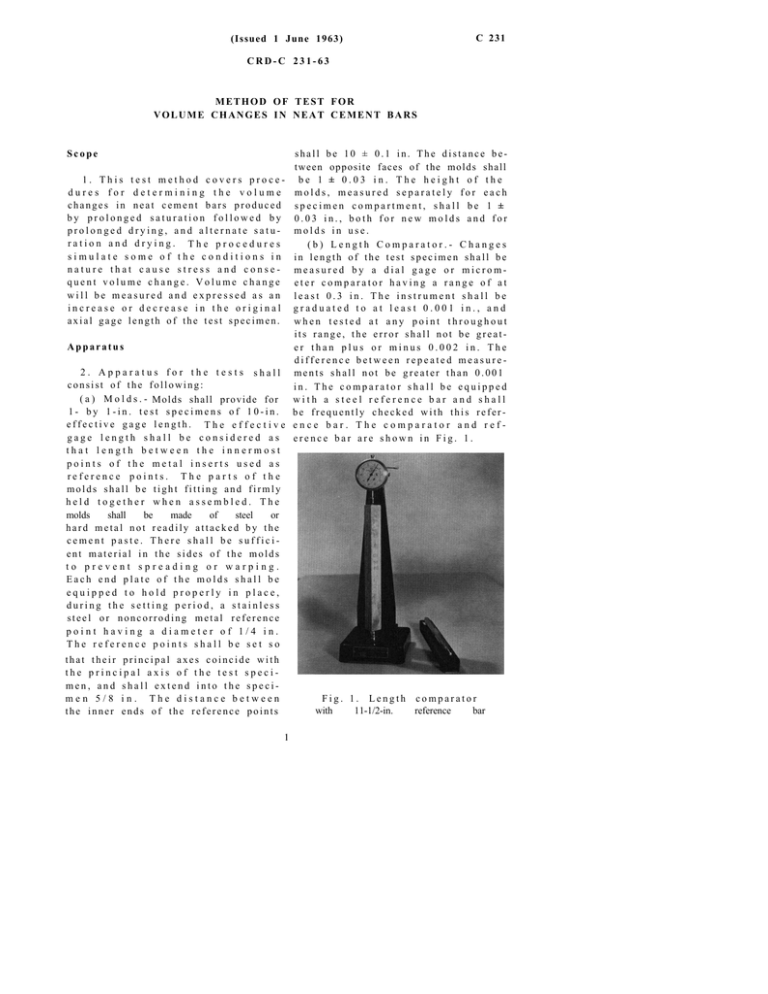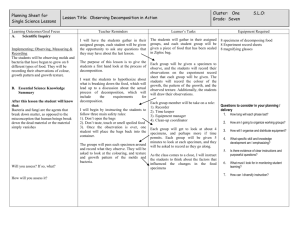C 231
advertisement

(Issued 1 June 1963) C 231 CRD-C 231-63 METHOD OF TEST FOR VOLUME CHANGES IN NEAT CEMENT BARS Scope shall be 10 ± 0.1 in. The distance between opposite faces of the molds shall 1. This test method covers proce- be 1 ± 0.03 in. The height of the d u r e s f o r d e t e r m i n i n g t h e v o l u m e molds, measured separately for each changes in neat cement bars produced specimen compartment, shall be 1 ± by prolonged saturation followed by 0.03 in., both for new molds and for prolonged drying, and alternate satu- molds in use. ration and drying. The procedures (b) Length Comparator.- Changes s i m u l a t e s o m e o f t h e c o n d i t i o n s i n in length of the test specimen shall be nature that cause stress and conse- measured by a dial gage or micromquent volume change. Volume change eter comparator having a range of at will be measured and expressed as an least 0.3 in. The instrument shall be increase or decrease in the original graduated to at least 0.001 in., and axial gage length of the test specimen. when tested at any point throughout its range, the error shall not be greatApparatus er than plus or minus 0.002 in. The difference between repeated measure2 . A p p a r a t u s f o r t h e t e s t s s h a l l ments shall not be greater than 0.001 consist of the following: in. The comparator shall be equipped ( a ) M o l d s . - Molds shall provide for w i t h a s t e e l r e f e r e n c e b a r a n d s h a l l 1- by 1-in. test specimens of 10-in. be frequently checked with this refereffective gage length. T h e e f f e c t i v e e n c e b a r . T h e c o m p a r a t o r a n d r e f gage length shall be considered as erence bar are shown in Fig. 1. that length between the innermost points of the metal inserts used as reference points. The parts of the molds shall be tight fitting and firmly held together when assembled. The molds shall be made of steel or hard metal not readily attacked by the cement paste. There shall be sufficient material in the sides of the molds to prevent spreading or warping. Each end plate of the molds shall be equipped to hold properly in place, during the setting period, a stainless steel or noncorroding metal reference point having a diameter of 1/4 in. The reference points shall be set so that their principal axes coincide with the principal axis of the test specimen, and shall extend into the specimen 5/8 in. The distance between the inner ends of the reference points Fig. 1. Length comparator with 11-1/2-in. reference bar 1 (Issued 1 June 1963) 2 TEST FOR VOLUME CHANGES IN NEAT CEMENT BARS (C 231-63) Test Specimens Measuring Procedure 3. T h e t e s t s p e c i m e n s s h a l l b e 1 - i n . by 1-in. by 11-1/4-in. bars, with stainless steel reference points at each end of the longitudinal axis, providing an effective initial gage length of exactly 10 in. The preparation of the specimens shall be as follows: (a) Preparation of Molds.- Molds shall be thinly covered with mineral oil; after this operation the stainless steel or noncorroding metal reference points shall be set, care being taken to keep them clean and free of oil. (b) Mixing Cement Paste.- The standard batch shall consist of 500 g of cement with sufficient water to give a paste of normal consistency, and shall be mixed in accordance with the procedure described in CRD-C 220. (c) Molding Specimens.- I m m e d i ately following completion of mixing, the test specimen shall be molded in one or two layers, each layer being compacted with the thumbs or forefingers by pressing the paste into the corners, around the reference inserts, and along the surfaces of the molds until a homogeneous specimen is obtained. After the top layer has been compacted, the paste shall be cut off flush with the top of the mold and the surface smoothed with a few strokes of the trowel. During the operations of mixing and molding, the hands shall be protected by rubber gloves. 5. The length change measurements shall be made in accordance with the requirements of CRD-C 25. There should be no change in the temperature and the humidity conditions surrounding the test specimens and instrument during length measurements. The measuring apparatus shall be kept in the room in which the specimens are stored. All measurements shall be made as quickly as accuracy will permit. The reference bar shall be measured after specimen measurements have been made as well as before. Storage 4. Immediately after molding, the specimens shall be placed in the moist room, which shall be maintained at a relative humidity of at least 90 percent and at a temperature of 73.4 F ± 2 F. At the end of 24 hr ± 2 hr, the specimens shall be removed from the molds and placed in clean water at a temperature of 73.4 F ± 2 F for a curing period of 28 days or as otherwise required. Procedure 6. (a) Prolonged Saturation.- The lengths of the bars shall be measured immediately after the specimens are removed from the molds. The bars shall then be immersed in water at the specified temperature. The bars shall be removed from the water and measured every 2 days to 14 days, then every 14 days to 90 days. (b) Prolonged Drying.- At the end of 90 days, the bars shall be removed to air and dried at 73.4 F ± 2 F and a relative humidity of 50 ± 5 percent for 90 days (or longer if constant length has not been reached at that age). The length of the bars shall be measured every 2 days to 14 days, then every 14 days to 90 days. The exact temperature of the specimens shall be recorded at each reading. Adjustments for temperature irregularities shall be applied after coefficients of thermal expansion for the individual cements have been determined. A continuous graph of the length changes observed shall be plotted. (c) Continued Saturation.- Bars remaining in water longer than 90 days shall be measured every 28 days until completion of the period determined for the test. (Issued 1 June 1963) C 231 TEST FOR VOLUME CHANGES IN NEAT CEMENT BARS (C 231-63) 3 (d) Alternate Saturation and Dry- s h a l l t h e n b e i m m e r s e d i n w a t e r ing.- At the end of the 28-day curing at 73.4 ± 2 F for 28 days, removed, period, the lengths of the bars shall measured, and the temperature rebe measured and the temperature re- corded. The bars shall be alternately corded. The bars shall then be ex- i m m e r s e d 2 8 d a y s a n d a i r - d r i e d posed to air at 73.4 ± 2 F with a 2 8 d a y s f o r t h e d e s i r e d n u m b e r o f relative humidity of 50 ± 5 percent for reversals. The length change shall 2 8 d a y s , m e a s u r e d a g a i n , a n d t h e be computed, and a graph plotted of the temperature recorded. T h e b a r s alternate expansion and contraction.






